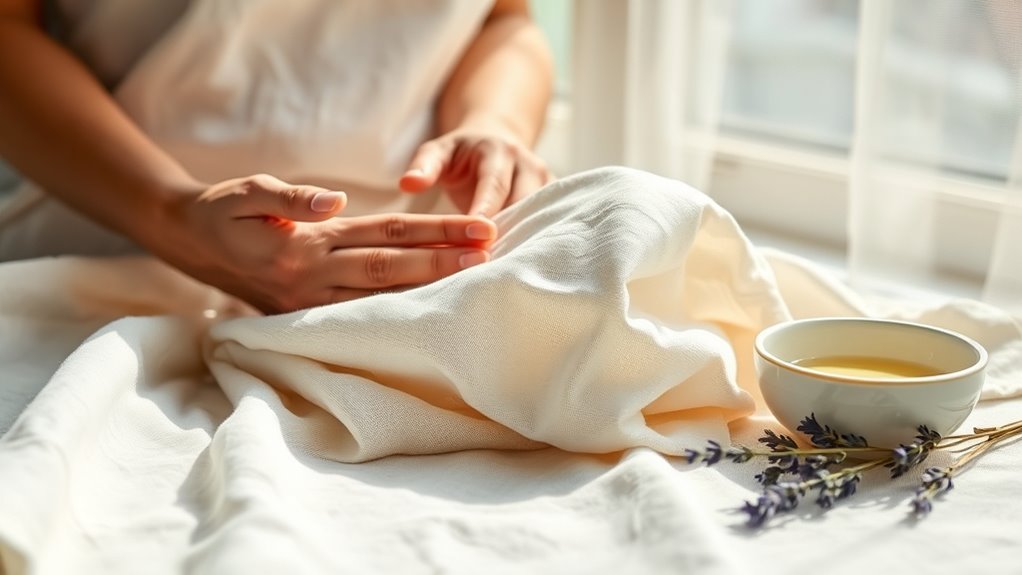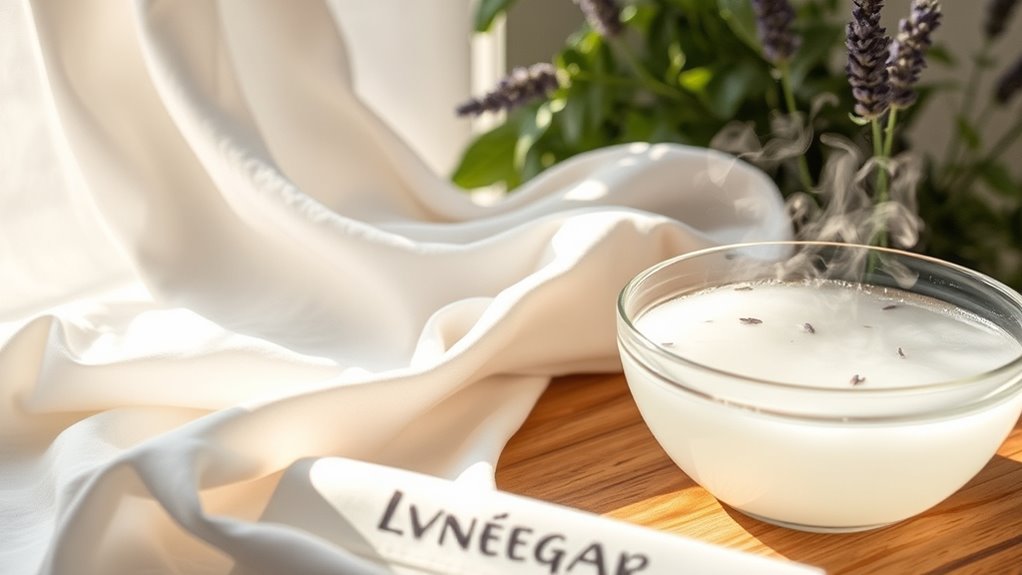To soften stiff fabrics naturally, add half a cup of white vinegar during the rinse cycle to break down detergent residues and neutralize odors. You can also sprinkle half a cup of baking soda with your laundry to boost softening, especially in hard water. Sun-drying outdoors helps relax fibers, making fabrics feel more supple. For extra softness and a gentle scent, try using a few drops of natural oils like coconut or jojoba on damp clothes. Keep exploring for more effective tips!
Key Takeaways
- Add half a cup of white vinegar during the rinse cycle to neutralize detergent residues and soften fabrics naturally.
- Incorporate half a cup of baking soda into laundry to balance water pH and reduce stiffness.
- Use a few drops of coconut or jojoba oil on a damp cloth and toss it in the dryer to coat fibers with gentle oils.
- Hang clothes outside in sunlight and fresh air to relax fibers and enhance softness naturally.
- Combine natural treatments with sun-drying for plush, comfortable fabrics without harsh chemicals.

Ever wondered how to make your fabrics feel softer and more comfortable? If you’re tired of stiff, scratchy textiles, there are simple, natural ways to soften them without relying on commercial fabric softeners. Fabric softening tips include using natural fabric treatments that not only improve the texture but also preserve the integrity of your clothes and linens. These methods are eco-friendly, cost-effective, and gentle on your skin, making them perfect for all types of fabrics.
One of the easiest fabric softening tips is to use white vinegar during the laundry cycle. Vinegar acts as a natural fabric softener by breaking down detergent residues that can cause stiffness. Pour half a cup of white vinegar into the rinse cycle, and avoid using it with bleach, which can weaken fibers. The vinegar neutralizes any leftover soap and softens fabrics, leaving them feeling smooth and fresh. Plus, it helps eliminate odors and keeps colors vibrant. For best results, you can also add a few drops of essential oil like lavender or eucalyptus to the vinegar for a subtle, natural fragrance.
Use white vinegar in the rinse cycle to naturally soften fabrics and remove detergent residues.
Another effective natural fabric treatment involves using baking soda. Adding half a cup of baking soda to your wash not only boosts detergent performance but also softens fabrics. Baking soda balances the pH level of the water, which helps break down minerals and residues that contribute to stiffness. It’s particularly useful for hard water areas. Combine it with your regular laundry detergent, and your fabrics will come out feeling softer and more comfortable. For even more softness, you can soak stubbornly stiff items in a solution of warm water mixed with baking soda before washing.
You can also try using natural oils as fabric softeners. Add a few drops of coconut or jojoba oil to a damp cloth and toss it into the dryer with your clothes. The gentle oils coat the fibers, resulting in a softer, more supple feel. This is a great alternative to commercial dryer sheets and adds a light, natural scent. Just be cautious not to use too much, as excess oil can leave residue or make fabrics feel greasy.
Finally, sun-drying your textiles can naturally soften fabrics over time. Hanging clothes outside in fresh air and sunlight helps break down stiffness and enhances softness. The gentle breeze and UV rays work together to relax fibers and remove any residual stiffness. Combining natural fabric treatments with sun drying is an effective, eco-friendly way to achieve plush, comfortable fabrics. With these natural fabric treatments and fabric softening tips, you can enjoy softer, more comfortable textiles without harsh chemicals, all while caring for your clothes and the environment.
Frequently Asked Questions
Can Natural Softening Methods Damage Delicate Fabrics?
Natural softening methods generally won’t damage your delicate fabrics if you follow proper techniques. You help preserve fabric fiber integrity and dye preservation by avoiding harsh chemicals and excessive agitation. Gentle treatments like soaking in vinegar or using natural conditioners are safe, but always test a small area first. This way, you guarantee your fabric stays soft without compromising its quality or color, keeping it looking fresh and vibrant longer.
How Often Should I Soften Fabrics to Maintain Their Quality?
You should soften fabrics every few washes, depending on their stiffness and fabric care frequency. Establish a gentle softening schedule to keep your textiles comfortable without risking damage. Pay attention to how the fabric feels; if it becomes stiff again, it’s time for another natural softening treatment. Over-softening can harm delicate fibers, so balance your softening efforts with proper washing and drying routines to maintain fabric quality.
Are There Any Fabrics That Shouldn’t Be Softened Naturally?
Certain fabrics, like silk, wool, and linen, might not be suitable for natural softening methods due to fabric compatibility and softening limitations. You should avoid using harsh treatments on delicate or sensitive textiles, as they can damage fibers or alter textures. Always check care labels first, and test any softening method on a small, hidden area to verify the fabric’s integrity remains intact.
Can Softening Treatments Affect Fabric Longevity?
Softening treatments can impact fabric longevity if you’re not careful. You need to consider fabric fiber compatibility and softening process safety to avoid damage. Some fibers, like silk or wool, may weaken or lose their durability with improper softening methods. Always test a small area first and follow gentle, natural techniques to ensure your fabric stays strong and looks great over time.
Is There a Way to Soften Fabrics Without Water or Chemicals?
Imagine giving your fabric a gentle hug without getting it wet or using harsh chemicals. You can try DIY remedies like using a softening spray made from natural oils or commercial products designed to relax fibers without water. These methods help loosen stiff fabrics, making them more comfortable to wear or use. Just spray lightly and let it sit, then gently work the fabric to achieve that soft, inviting feel you desire.
Conclusion
By gently nurturing your fabrics and giving them a little extra care, you help them regain their softness and beauty. Sometimes, patience and a tender touch are all they need to feel comfortable again. Remember, even the stiffest material can become inviting with the right gentle approach. So, take your time, enjoy the process, and soon your fabrics will welcome you with a cozy, inviting feel—proof that kindness can transform even the most stubborn.









